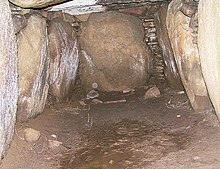User:Sebastian bttrch/Hulbjerg Jættestue
Hulbjerg Jættestue | |
 Hulbjerg Jættestue | |
| Location | Langeland, Denmark |
|---|---|
| Region | Scandinavia |
| Coordinates | 54°44′10″N 10°41′05″E / 54.7360465°N 10.6845932°E |
| Type | Passage grave |
| History | |
| Periods | Neolithic |
| Cultures | Funnelbeaker culture |
| Site notes | |
| Excavation dates | 1961 |
| Archaeologists | Håkon Berg |
| Ownership | Public |
| Public access | Yes |
The Hulbjerg Passage Grave (danish: Hulbjerg Jættestue) is a Passage grave located at the southern end of the danish island Langeland, situated on a 15 meter hill south of the ferry harbour Bagenkop. Dating back to the 3300 - 3200 BEC, it is part of the neolithic Funnelbeaker culture, in short TRB or TBK. The grave consists of a chamber and a separate lateral passage way. This form of grave is predominantly found in Germany and Scandinavia, and to a lesser extent in France and the Netherlands. [1]
Description[edit]
The rectangular grave chamber is embedded in a round barrow of about 20 m diameter, framed by a ring of stones. The walls of the 6.5 x 1.7 metre chamber consist of 13 large uprights, tightly compacted with a fine wall of hewn stone tiles. On the exterior, the chamber is sealed with clay layered with crushed flint. The ceiling originally consisted of five large slabs of rock, of which three remain, complemented by two granite beams in 1961. The floor was laid with small flat stones covered in burnt flint. On the southern wall of the chamber, vertical stone plates form a separate section.
The passage way, 5 m long and uncommonly wide for this type of grave, opens in two places, with stone doorframes and doorsteps. At its one end lies a big flat stone, presumably used to close the entry.

Excavation[edit]
In 1960, the grave was excavated by one of Europe's leading experts in late Stone Age burials, Håkon Berg of the Langeland Museum. In the separate section in the grave chamber, sharpened flint axes and chisels, flint daggers, transverse arrowheads, decorated ceramics, amber beads as well as heaps of bones of 36 adults and 17 children were found. A skull found in the passage shows what might be the earliest known records of dental treatment: a flint drill had been used to drill down to - and possibly puncture a painful abscess in - the root canal of a molar tool. [3]
Accessibility[edit]
The grave is located on public ground and is accessible all year. The parking lot is placed by the foot of the Hulbjerg hill. As the entry passage is low, one needs to crawl into the grave. [4]
The excavated objects are on exhibition at the Langeland Museum in Rudkøbing.
See also[edit]
Footnotes[edit]
- ^ Johannes Müller: Neolithische Monumente und neolithische Gesellschaften. In: Hans-Jürgen Beier, Erich Claßen, Thomas Doppler, Britta Ramminger (Hrsg.): Varia neolithica VI. Neolithische Monumente und neolithische Gesellschaften. Beiträge der Sitzung der Arbeitsgemeinschaft Neolithikum während der Jahrestagung des Nordwestdeutschen Verbandes für Altertumsforschung e.V. in Schleswig, 9.–10. Oktober 2007 (= Beiträge zur Ur- und Frühgeschichte Mitteleuropas. Bd. 56). Beier & Beran, Langenweißbach 2009, ISBN 978-3-941171-28-2, S. 7–16, hier S. 15.
- ^ "Hulbjerg Passage Grave" Archived 2018-04-12 at the Wayback Machine Retrieved on 1 August 2018
- ^ "Hulbjerg Passage Grave" Archived 2018-04-12 at the Wayback Machine Retrieved on 1 August 2018
- ^ "Hulbjerg Passage Grave at Langeland website" Hulbjerg Passage Grave at Langeland.dk at the Wayback Machine (archived 2018-08-03) Retrieved on 3 August 2018
References[edit]
- Karsten Kjer Michaelsen: Politikens bog om Danmarks oldtid (= Politikens håndbøger.). Politiken, Kopenhagen 2002, ISBN 87-567-6458-8, S. 146, 147 und 162.
- http://denstoredanske.dk/Danmarks_geografi_og_historie/Danmarks_historie/Danmarks_forhistorie/Hulbjerg
